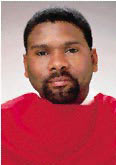| FITTING FRAMES |

|
Skin Tone Considerations
According to Soltis, skin tones should also be considered. "About 40 percent of the population has a warm, yellow skin tone and 60 percent of the population has a cool, blue skin tone."
Soltis explains that the best way to determine whether someone has a warm or cool skin tone is to simply drape an orange fabric swatch around their face first and then drape a burgundy swatch around the face after that. If the orange swatch blends with the skin, the person has a warm tone. If burgundy looks better, then the person has a cool skin tone. Almost every color has a warm or cool undertone-except orange and burgundy, according to Soltis. In metals, the rule of thumb is silver looks best with cool skin, and gold looks better on warm skin.

|

|
After
Face Shapes and Frame Selection
In terms of face shapes, here's a breakdown of what frames look best:
Oval: Select styles as wide as or slightly wider than the broadest part of the face. Aviators and wayfarers are a good choice.
Round: Select angular styles no wider than the widest part of face. Butterfly shapes, squares, and rectangles fit well.
Diamond: Balance the angles of the face with softly curved styles no wider than the top of cheekbones. Teacup frames are a good choice.
Inverted triangle: Minimize the upper portion of the face by selecting frames no wider than the forehead and angling outward at the bottom corners. Squared aviators work well.
Triangle: Add width to the forehead by choosing styles angling outward at the top corners that are slightly wider than the broadest part of the jawline. Cateyes are a good choice.
Square: Reduce the squareness with softly curved styles such as classic ovals.
Oblong: Make the face appear shorter by choosing styles that extend beyond the widest part of the face. Deep aviators are ideal.
Safety and Service Considerations
Beyond the aesthetics of eyewear, Soltis points out that there are safety and visual considerations that apply specifically to older people.
"They are more sensitive to light, which means traffic glare can be downright dangerous to them," she says. "Combine that with the fact that they have a slower reaction time when they are driving, and it's evident they need all the help they can get." That's why she says that lenses with anti-reflective coatings and polarized sunglasses are more important to older people than ever because they help eliminate glare and the eyestrain of night driving.
"It's also more important that they get regular eye checkups," she adds.
Finally, Soltis advises dispensers to choose words tactfully when recommending eyewear to older people. No patient wants to hear: "Well, these frames will shorten that nose," or, "This tint will really help conceal those lines around your eyes."
According to Soltis, "Your approach should suggest that you are enhancing an attractive face, not performing a rescue operation."
She concludes: "Most older people are retired and aren't in a rush, which means you can take your time to give them exceptional service and fit them just right. While you're at it, you'll probably hear a good story about what they did when they were on their last cruise or how much money they won in Atlantic City too." EB




